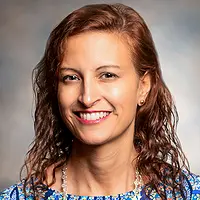
Editor’s Note: As Head of Global Diversity, Equity & Inclusion, Kristina Brunelle writes monthly messages for RTI staff, encouraging us to reflect on our lived experiences with structural and interpersonal bias, and how we can foster a culture of belonging at work and beyond. We invite the Insights audience to join us in the same spirit of reflection.
As a child, growing up just outside of New York City, I was surrounded by Spanish speakers. My mother taught ESL (English as a Second Language) at a local college, to classes filled with immigrants from Honduras, El Salvador, Mexico, Paraguay, Colombia, Peru, Venezuela... Her students were doctors, lawyers, physicists, pharmacists, clergy, business owners, parents, grandparents… They worked menial jobs, usually outside of their chosen fields, during the day and came to learn from my mother at night. All of them shared a common dream, to improve their English so they could get a better paying job in this “land of opportunity” they now called home. Many of them were here by themselves, working diligently to earn enough money to pay the rent, while also sending as much money as possible back to their families in Latin America. Some hadn’t seen those families in years.
The summer after I graduated from high school my mother asked her students if anyone had a family back in their home country that would be willing to have me come stay for a few months, attend a local school, and learn to speak Spanish in exchange for paying them room and board. The following Spring, I stepped off a plane in San Pedro Sula, Honduras, with only a red rose in my lapel to identify me to my host family. (This was 1989—smartphones didn’t exist.) By that point I had taken 6½ years of Spanish and could more or less read and write, but casual conversation was a tad beyond my capabilities. The first few weeks with my host family were painful—for everyone. I couldn’t understand them and they couldn’t understand me. I carried a dictionary everywhere I went. There were lots of hand gestures. Sometimes there was laughter (theirs), sometimes there were tears (mine). But there was always a lot of patience on their part (thank goodness) and eventually I began to get the hang of articulating my thoughts in a way that others could comprehend. We all learned—a lot.
Every year hundreds of thousands of people from other nations arrive in the United States seeking a better life than the one they’ve left behind. Sometimes they are leaving for financial reasons, sometimes political, sometimes because of personal safety, but in the majority of cases they leave the comfort of what they have known as “home” because they think their lives, and the lives of their families, will be better if they can live and work in the U.S. Many of them work multiple jobs, doing without, so their families can survive. They have contributed in innumerable ways to the culture and history of the United States, through music, politics, finance, education, healthcare, childcare, science, cuisine, law, entertainment, sports—I am challenged to name a field that has not been influenced by someone from another country. These contributions are a major part of what makes up the tapestry of our nation.
This year marks the 32nd anniversary of President Bush (Senior) officially recognizing September 15 as the start of National Hispanic Heritage month—a celebration that recognizes and promotes the history, culture, and contributions of Hispanic-Americans—specifically, those whose ancestors came from Spain, Mexico, the Caribbean, and Central and South America. Communities all over the United States mark the incredible achievements of Hispanic and Latinx Americans with festivals and educational activities.
This month, watch for events and activities nationwide where you can learn more about Latinx culture, accomplishments, and contributions to society. I encourage you to read more about this month of celebration and how you can participate. I’m sure you will come away enriched, just like our nation.
